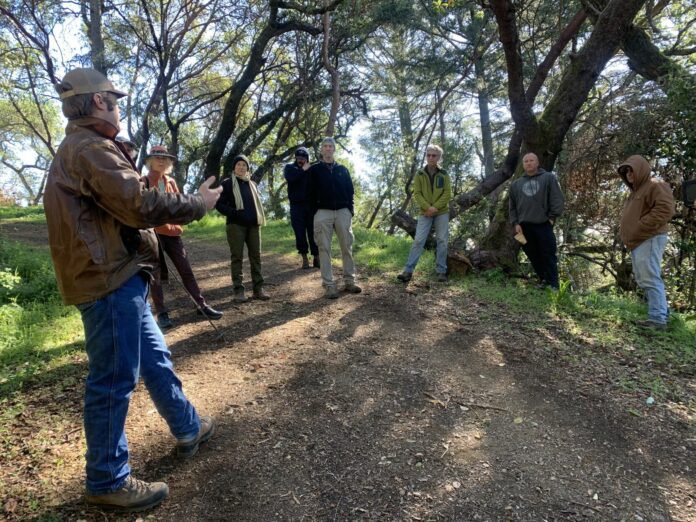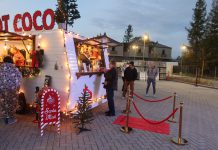
Registered forester Jacob Harrower discusses the vegetation management work that was recently completed on Fitch Mountain.
With the help of Coastal Conservancy grant monies, the Healdsburg Fire Department, in partnership with the Northern Sonoma County Fire District Fuels Crew, recently completed a large vegetation management project on Fitch Mountain, including trimming back overgrown understory brush, thinning tree crown canopies and clearing trees where needed.
Now that the preliminary vegetation management work is completed, crews can prepare for debris pile burning and a 25-acre prescribed burn, which Healdsburg Fire and Northern Sonoma County Fire District officials hope to get done this year prior to the start of fire season.
The prescribed burn would be conducted by CalFire crews.
Healdsburg Fire Marshal Division Chief Linda Collister said she hopes they can also collaborate with local Indigenous tribes to conduct cultural burns, low and slow burns that help restore land to its natural state by clearing invasive species and giving a healthy trim to overgrown native brush.
Last July, the City of Healdsburg was awarded $919,000 in grant funds from the Coastal Conservancy for wildfire fuels management projects on Fitch Mountain and at the Healdsburg Ridge Open Space Preserve.
$505,000 was awarded for defensible space, shaded fuel breaks and fuels management projects at the Fitch Mountain Open Space Preserve and $414,000 was awarded for fuel management and control line projects at the Healdsburg Ridge Open Space area.
A major portion of the grant also went toward procuring goat grazing services for Fitch Mountain. In July, herds of goats worked on the slopes of Fitch Mountain, a precursor to the human-led fuels management project that crews just completed.
“We’re hoping that if a fire occurs outside of the (fuels work) perimeter and moves up the area, that’s our first line of defense to stop the fire from coming on the preserve,” Collister said during a March 4 Fitch Mountain community meeting that was held to discuss the recent fuels work.
Collister, Northern Sonoma County Fire District Chief Marshall Turbeville, Erick Dicke and registered forester Jacob Harrower met with Fitch residents at the top of Fitch Mountain to provide a tour of all the work that was completed and answer questions.
“The ultimate goal here is to do what fire would’ve naturally done, low intensity, not damaging all of the trees … My biggest fear here is if this community burns down, mainly the unincorporated part, it is going to be very hard for you guys to build back your homes, so we need to do all we can do to prevent that in the first place,” Turbeville said.
Before the fuels reduction work could begin, Harrower worked with the California Vegetation Treatment Program with the state board of forestry and fire protection to create a vegetation treatment program plan. He also had to conduct a biological, botanical and archeological survey, and a forest health assessment.
Once the surveys and studies were completed, fuels crews used various methods for cleaning the slopes and trails of Fitch Mountain.
Erick Dicke, of Erick Dicke Road Construction, used a demasticator to clear away large vegetation debris and trees. Crews were also able to limb up trees, meaning removing the lower branches of a tree.
“With demastication we are changing the vertical fuels to horizontal, we’re reducing the surface fire intensity. That’s why I am really comfortable (with) prescribed burning here,” Turbeville said.
Now that trees have been limbed up and vegetation has been trimmed, the cleared areas will make it easier for air tankers to make retardant drops if needed.
“It’s so important that we have all these different kinds of fuel treatment. He can go a long way and augment what the fuels crew is doing,” Collister said, referring to Dicke. “They’re doing the steeper hills and he can do a lot of work, chipping and taking down smaller trees.”
One of the aims of vegetation management work is to reduce the risk of large, destructive fires. If a fire does occur in an area where vegetation management work has been done, the goal is that the brush and fuel clearing will help prevent the fire from reaching the crows of trees.
“What we want to avoid is the big fire, which kills everything and kind of denudes the surface. It will destroy the soil resources, it will destroy the seed banks and what it does is it converts ground and we’re seeing California be converted right before our eyes. It’s going from conifer forest or oak woodland and it’s been that way for hundreds of years, thousands of years and it’s being converted to a shrubland or chaparral which will grow back and want to be burned. That’s what’s happening in California right now and in order to stop it we need to go back. We need to remove enough of the small trees, and even some of the bigger trees where they’ve grown in such a way where there hasn’t been this disturbance,” Harrower said.
Harrower said if they don’t continually conduct prescribed burns, everything will just grow right back and they’ll be back to square one.
“We’re trying to leave more shade so less stuff will grow in the understory and that’s another big part of this design, is leaving a lot of shade. You’ll see as we walk through, we’ve removed maybe 15% of the canopy. I think it is a good thing to leave an 80% canopy or more to prevent a lot of those grasses that come in and really start the fire. If there’s a canopy fire coming through here and high winds, it’s probably not going to stop it but up on the ridge here we were a little more aggressive with the demastication, taking out more trees so that if the fire is coming up in the canopy, maybe we can stop it at the ridge and we have that break in the canopy,” Harrower explained.
More brush and canopy means there’s more of a chance for a fire to climb up to the crowns — the tops of trees. Once a fire reaches the crowns it burns hot and fast and is very difficult for firefighters to contain. Ground fires burn slower and are much easier to control.
Logistically speaking, Fitch Mountain is the “launching board” for embers from a fire to spread down to the city of Healdsburg, which is why protecting and shoring up Fitch Mountain is so important.
“By doing this it benefits the mountain, but it also benefits the town too,” Turbeville said.
Laura Tietz, who started Fire Free Fitch, is credited with starting the vegetation management movement on Fitch Mountain. Well into her eighties, Tietz would go door to door on Fitch Mountain and tell people to clean their yards and clear away overgrown brush.
“Laura Tietz, who’s near and dear to my heart, she was the one who started Fire Free Fitch, the reason all this happened,” Collister said.
In one of the areas of Fitch Mountain called Mother’s Grover where they cleared away vegetation, the Tietz family hopes to erect a bench in honor of Laura Tietz.







